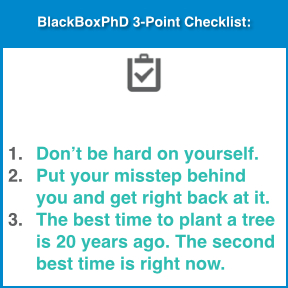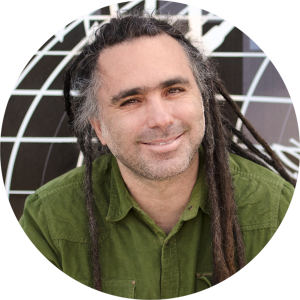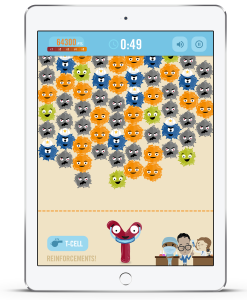 Gamification Ramifications With Michael Fergusson
Gamification Ramifications With Michael Fergusson

Michael Fergusson
Small changes in behavior can make a huge impact, especially in health. One way to get people to make small changes is to make it fun for them to change, by using games and gamification. Most of us know what games and video games are, and many people have heard the word gamification, but what does it really mean? Michael Fergusson is the CEO of Ayogo, a company that integrates social networking and gaming to help improve patient health behaviors. His work is at the cutting edge of mobile health applications, and both he and Ayogo have received national awards in this area.
Michael, please tell us about your background and how your interests with medicine, social networking, and games have come together.
I started my career in technology in the mid-nineties, just as we were all starting to realize the impact the internet and the web were going to have. Right from the beginning I was working with social software – some of my earliest projects were converting dial-up bulletin board systems to web-based discussion forums – so, right from day one I was fascinated by the social aspect of that technology. In 2001, I founded a company called Enfolding Systems to develop enterprise collaboration tools and in the course of that work noticed that the process that go through to (for example) collaboratively edit a paragraph of text looks a lot like, well… play. There are rules, both implicit and explicit, there is cooperation, competition, and a final “win” state. I became increasingly interested in how to use that insight, that much of what we consider to be “serious” work can be thought of as a kind of social play. When Paul Prescod and I were founding Ayogo, we wanted to use this insight, together with a lot of great work we had done building successful social games on Facebook in the meantime, to create something important and solve serious problems. We began to experiment and develop the business plan, and ultimately saw that we could have a significant impact on the enormous problem of patients simply not doing the right things for their health.
How can the technologies you work with be used to help improve people’s lives?
Healthcare, quite rightly, is delivered by highly qualified people using very precise language in very controlled environments that value dispassionate reasoning as the best way to determine how to act. This is roughly the opposite of real life. In fact, if you were going to design an environment guaranteed to have a minimal impact on the behavior of ordinary people, it would look a lot like that. Just to pick two aspects of Ayogo’s technology: our specialized social networking system delivers social proofs that help a patient feel empowered, our gamification framework helps them feel a sense of mastery that keeps them engaged and active.
People throw around the world gamification, but it’s unclear how you make something gamified. For example, do you use points, badges, leaderboards, etc? Is there a recipe for gamification?
 Points, badges and leaderboards are not gamification any more than page numbers and chapter headings are literature. That’s just making something look like a game, and won’t be any more successful that trying to ride something that only looks like a bicycle but has none of the underlying mechanics that make a bicycle work. To think about this another way, I can tell you that my high score in Ms. Pac Man is 185,211 and that may not mean anything to you, but to an avid player of that game it will tell them a lot about how good I am, how well I have mastered that game. The points are only the outward expression of my mastery. If I just put quarters in the machine and got a random score assigned to me I would feel no emotional connection to it. You could call that “gamifying” the process of getting quarters from me if you like, and you may even be able to get me to put in a quarter or two, but ultimately anyone who saw that would agree that it is not a game.
Points, badges and leaderboards are not gamification any more than page numbers and chapter headings are literature. That’s just making something look like a game, and won’t be any more successful that trying to ride something that only looks like a bicycle but has none of the underlying mechanics that make a bicycle work. To think about this another way, I can tell you that my high score in Ms. Pac Man is 185,211 and that may not mean anything to you, but to an avid player of that game it will tell them a lot about how good I am, how well I have mastered that game. The points are only the outward expression of my mastery. If I just put quarters in the machine and got a random score assigned to me I would feel no emotional connection to it. You could call that “gamifying” the process of getting quarters from me if you like, and you may even be able to get me to put in a quarter or two, but ultimately anyone who saw that would agree that it is not a game.
Gamification is creating systems that express the essential qualities that make a game, but have a serious purpose. Those essential qualities are: Agency, Conflict, Uncertainty, Discoverability, and (meaningful) Outcomes. I call it ACUDO for short. I’ve got a short paper on this published on the Ayogo blog for anyone interested in learning more.
What are some of the “coolest” games you have created? Did “cooler” games work better in changing behavior?
Everybody’s idea of “cool” is a bit different, so it’s hard to answer that question. We’ve certainly built games that were a lot of fun to play, regardless of health or educational outcome. That’s usually not a primary goal of our work, as we’re quite focused on healthcare outcomes. Having said that, we built a really fun game called “T Cells Attack!” which models some interesting immune system functions in a sort of bubble-shooter hybrid

T Cells Attack
(http://www.gene.com/stories/t-cellsattack). We built a 3D board game for the Provincial Government to help kids learn about alternative careers in different regions around our home Province of British Columbia. In those cases, the visual aesthetics and clear “win” states served a purpose and weren’t an end in themselves.
What are the biggest challenges is your work? How have you overcome them?
There are so many, it’s not possible to choose a single greatest one. Explaining to people what gameification really is (and isn’t) is a real challenge, as is working with the very long sales cycles and stifling bureaucracy of large healthcare companies. Just as they say, though: every challenge is an opportunity in disguise.
What do you believe is most important in keeping people engaged, especially with their health?
Understanding that people make decisions emotionally and justify those decisions intellectually. If you’re focused on educating and rationalizing, you’re missing the key decision point.
What are three key pieces of advice you have for people who are struggling to keep on top of their health regimens?
Don’t be hard on yourself. Everybody struggles with this. The worst thing you can do is punish yourself just for being human. Put your misstep behind you and get right back at it. As the chinese proverb goes: the best time to plant a tree is 20 years ago. The second best time is right now.
For more information on Michael Fergusson, check out the Ayogo blog.

Pingback: the future of bitcoin
Pingback: dlan test
Pingback: Taruhan Olahraga
Pingback: wietbon online
Pingback: bandar judi bola
Pingback: iraq law
Pingback: Corporate Event Managers Hyderabad
Pingback: how to make money with a iphone
Pingback: Engineer Aws Alkhazraji
Pingback: iraq Colarts2
Pingback: formasi cpns 2018 sma
Pingback: cpns resmi 2018
Pingback: GVK BIO
Pingback: gvk bio company in india
Pingback: tanggal berapa cpns 2018 dibuka
Pingback: warehouse for sale
Pingback: UK Chat Rooms
Pingback: Tree of Innovation Digital
Pingback: seo salt lake city
Pingback: forex signals
Pingback: blokeringer
Pingback: sciences
Pingback: http://www.1beefjerky.com
Pingback: DMPK serices
Pingback: have a peek at this site
Pingback: British Dispensary for sale
Pingback: tsn radio listen
Pingback: more info
Pingback: 토토사이트 추천
Pingback: learn this here now
Pingback: Neha Tyagi Escorts in Jaipur
Pingback: JAIPUR ESCORTS ALIYA SINHA
Pingback: BANGALORE COMPANION ESCORTS
Pingback: Dhruvi Jaipur Escorts Services
Pingback: JAIPUR ESCORTS SERVICES MODEL DRISHYA
Pingback: Heena Khan Bangalore Escorts Services
Pingback: Jiya Malik High Profile Jaipur Escorts Model
Pingback: FUN WITH JAIPUR ESCORTS PUJA KAUR
Pingback: BANGALORE ESCORTS Rozlyn Model
Pingback: SAPNA CHAUDHARY ESCORTS IN BANGALORE
Pingback: Selly Arora Independent Bangalore Escorts
Pingback: Enjoy With Jaipur Escorts Tanisha Walia
Pingback: RUBEENA RUSSIAN BANGALORE ESCORTS
Pingback: Bristy Roy Independent Bangalore Escorts
Pingback: SRUTHI PATHAK MODEL ESCORTS IN BANGALORE
Pingback: Bangalore Escorts Sneha Despandey
Pingback: MODEL HONEY PREET ESCORTS IN BANGALORE
Pingback: Radhika Apte Model Escorts in Bangalore
Pingback: Devika Kakkar Goa Escorts Services
Pingback: Diana Diaz Goa Independent Escorts Services
Pingback: Goa Escorts Services Eva J Law
Pingback: Rebecca Desuza Goa Independent Escorts Services
Pingback: Yamini Mittal Independent Escorts Services in Goa
Pingback: Simmi Mittal Kolkata Escorts Services
Pingback: Kolkata Escorts Services Ragini Mehta
Pingback: Navya Sharma Independent Kolkata Escorts Services
Pingback: Elisha Roy Goa Independent Escorts Services
Pingback: Alisha Oberoi Independent Escorts in Kolkata
Pingback: Diksha Arya Independent Escorts Services in Kolkata
Pingback: Kolkata Escorts Services Fiza Khan
Pingback: Ruby Sen Kolkata Independent Escorts Services
Pingback: Divya Arora Goa Independent Escorts Services
Pingback: Simran Batra Independent Escorts in Kolkata
Pingback: Ashna Ahuja Escorts Services in Kolkata
Pingback: Sofia Desai Escorts Services in Goa
Pingback: Goa Escorts Services Drishti Goyal
Pingback: Mayra Khan Escorts Services in Kolkata
Pingback: Sruthi Pathak Independent Escorts in Bangalore
Pingback: Ambika Ahuja Jaipur Escorts Services
Pingback: Sruthi Pathak Bangalore Female Escorts
Pingback: latestvideo sirius69 abdu23na6990 abdu23na90
Pingback: zcode system review
Pingback: Sruthi Pathak Bangalore Escorts Services
Pingback: Trully Independent Bangalore Escorts Services
Pingback: Fiza Khan Kolkata Independent Call Girls Services
Pingback: Ruchika Roy Kolkata Escorts Call Girls Services
Pingback: Fiza Khan Kolkata Independent Escorts Call Girls Services
Pingback: Fiza Khan Kolkata Call Girls Escorts Services
Pingback: Diksha Arya Kolkata Escorts Call Girls Services
Pingback: Diksha Arya Kolkata Independent Escorts Call Girls Services
Pingback: professional resume service
Pingback: 카지노사이트
Pingback: Cheap
Pingback: Nidika Offer Call Girls in Bangalore
Pingback: Hyderabad Escorts Call Girls Services
Pingback: Pune Escorts Services Call Girls
Pingback: Bangalore Cheap Escorts Sevices
Pingback: Goa Escorts Call Girls